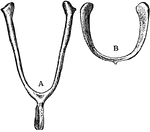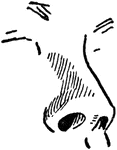
Female Nautilus without Shell
An illustration of a female nautilus without the shell. "c, points to the concave margin of the mantle-skirt…

Female Nautilus without Shell
An illustration of the postero-ventral view female nautilus without the shell. "a, Muscular band passing…

Inner Ear
"Transverse Section through Side Walls of Skull, showing the Inner Parts of the Ear. Co, concha or external…
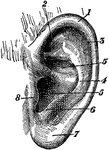
External Ear
"External Ear, or Pinna. 1, helix; 2, fossa of antihelix, or fossa triangularis; 3, fossa of helix,…
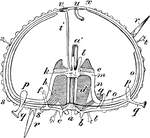
Sea Urchin Section
"Diagram of an Echinus (stripped of its spines). a, mouth; a', gullet; b, teeth; c, lips; d, alveoli;…
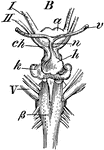
Skate Brain
"Brain of Skate (Raia batis), an elasmobranchiate fish. B, from below, in part enlarged: ch, optic chiasm;…
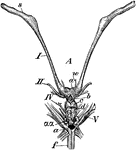
Skate Brain
"Brain of Skate (Raia batis), an elasmobranchiate fish. A, from above; s, olfactory bulbs; a, cerebral…

African Elephant Skeleton
"Skeleton and Outline of African Elephant (Elephas or Loxodon africanus). fr, frontal; ma, mandible;…
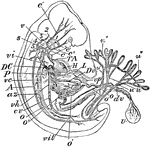
Human Embryo
"Early Human Embryo, giving diagrammatically the principal vessels antecedent to the establishment of…

Encephalon
"Diagram of Vertebrate Encephalon ... in longitudinal vertical section. Mb, mid-brain; in front of it…

Encephalon
"Diagram of Vertebrate Encephalon ... in horizontal section. Mb, mid-brain; in front of it all is forebrain,…

Crawfish Leg
"A, Developed Endopodite, or ordinary ambulatory leg of the crawfish as a thoracic appendage: ab, the…

Crocodile Thoracic Region
"Segment of Endoskeleton from Thoracic Region of Crocodile. C, centrum of a vertebra, over which rises…
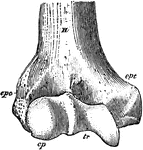
Humerus
"Anterior View, Distal End, of Right Humerus of a Man. H, humerus; epc, epicondyle, or external supracondyloid…

Gull Bill
The bill of the gull (Laridae) is epignathous: "hook-billed; having the end of the upper mandible decurved…
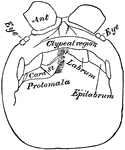
Centipede Head
"Head of Scolopendra, from below, showing the epilabrum, the protomala with its cardo (Card), and stipes…
Youth Femur
"Right Femur of a Youth. E, E, epiphyses; gtr, ltr, greater and lesser trochanter; h, head; et, it,…

Bobolink Epipleurae
"Epipleurae.-- Thorax, scapular arch, and part of pelvic arch of a bobolink (Dolichonyx oryzivorus).…

Copepod
Also known as fish lice, this is a species of copepod, a parasitic crustacean. "Female of Chondracathus…
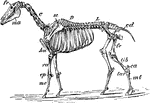
Horse Skeleton
"Skeleton of Horse (Equus caballus). fr, frontal bone; C, cervical vertebrae; D, dorsal vertebrae; L,…

Pike Cranium
"Cartilaginous Cranium of the Pike (Esox lucius), with its intrinsic ossifications. A, top view; 3,…
Pike Cranium
"Cartilaginous Cranium of the Pike (Esox lucius), with its intrinsic ossifications. B, side view: V,…
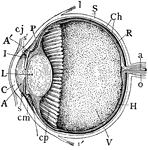
Median Vertical Anteroposterior Section of Eye
"Human Eye, in Median Vertical Anteroposterior Section. (Ciliary processes shown, through not all lying…

Right Eyeball of Bird
"Right Eyeball of Bird, seen from behind, showing the following muscles; a, rectus superior; b, rectus…
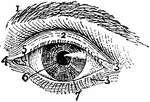
Exterior of Left Human Eye
"Exterior of Left Human Eye. 1, supercilium, or eyebrow; 2, palpebra superior, or upper eyelid; 3, 3,…

Muscles of Left Eyeball
"Muscles of Left Human Eyeball. so, superior oblique, passing through a trochlea or pulley; io, inferior…

Domestic Cat Skull
"Skull of Cat (Felis catus), showing the following bones, viz. : na, nasal; pm, premaxillary; m, maxillary;…
Anterior View of Human Right Femur
"Anterior View of Human Right Femur. ec, external condyle; etu, external tuberosity; ic, internal condyle;…

Posterior View of Left Femur of Horse
"Posterior View of Left Femur of a Horse. h, head; gtr, great trochanter; ttr, third trochanter; ltr,…

Cypris
Cypris, a modern ostracod. Female before sexual maturity, right valve of shell removed to show internal…

Fin-Footed Coot Foot
"In ornithology, pinnatiped; having pinnate feet, the toes being separately furnished with flaps, as…

Skeleton of Perch
"Skeleton of Fish (Perch). a, intermaxillaries; b, nasal region; c, dentary bone of mandible; d, orbit…
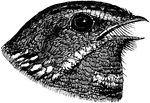
Fissirostral Bill of Nightjar
"In ornithology, having the beak broad and deeply cleft, as a swallow, swift, or goatsucker" or nightjar.…

Bones of Human Foot
"Bones of Human Foot, or Pes, the third principal segment of the hind limb, consisting of tarsus, metatarsus,…

Shortnose Sturgeon Tail
"Heterocercal Caudal Fin of a Sturgeon (Acipenser brevirostris), showing the series of fulcrums, Fl,…

Skull of Common Fowl
"Typical Skull of Common Fowl (Galliformes). A, side view: sa, surangular bone of mandible; ar, articular…

Skull of Common Fowl
"Typical Skull of Common Fowl (Galliformes). B, vertical longitudinal section: sa, surangular bone of…
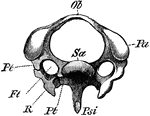
The Diagram of a Third Cervical Vertebra of a Woodpecker
"Third cervical vertebra of Woodpecker (Picus viridis). (Viewed anteriorly.) Ft, vertebrarterial foramen;…

The Skeleton of the Trunk of a Falcon
"Skeleton of the trunk of a Falcon. Ca, coracoid, which articulates with the sternum (St) at ; Cr, keel…

Skeleton of the Limbs and Tail of a Carinate Bird
"Skeleton of the Limbs and Tail of a Carinate Bird. (The skeleton of the body is indicated by dotted…

Diagram of the Pelvis of a Kiwi
"Pelvis of Apteryx austrlis. Lateral view. a, Acetabulum; il, ilium; is, ischium; p, pectineal process…

Diagram of the Skull of a Wild Duck
"Skull of a Wild Duck (Anus boscas), from the side. ag, Angular; als, alisphenoid; ar, articular; bt,…
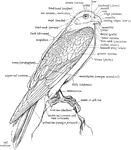
A Labeled Diagram of a Falcon to Show the Nomenclature of the External Parts
"The annexed figure explains the nomenclature of most of the outward of a Bird, but some further explanations…

Archaeopteryx Lithographica
"Archaeornithes is at present represented by but one member, the first undoubted fossil Bird, made known…
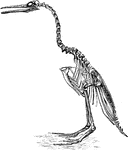
The Restoration of the Hesperornis Regalis
"Hesperornis regalis, (a fossilized restoration) which stood about three feet high, had blunt teeth…

Skeleton Head of a Ichthyornis
"Ichthyornis victor and I. dispar, ...were small forms of about the size of a Partridge, with the habits…

Flatworm
Flatworms are flattened, leaf-like forms living in damp places on land, in freshwater streams of ponds,…

Earthworm Anatomy
The earthworms are also known as megadriles, in the families Tubificidae, Lumbriculidae, and Enchytraeidae.…
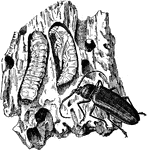
Beetle
Beetles are the group of insects with the largest number of known species. The general anatomy of beetles…
the Windpipe of a Male Red Breasted Merganser
"Trachea or windpipe of the red breasted merganser, Mergus serrator, about half natural size, viewed…
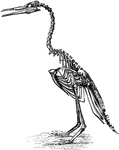
Restoration of Hesperornis regalis
"Hesperornis regalis, (a fossilized restoration) which stood about three feet high, had blunt teeth…
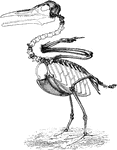
Restoration of Ichthyornis
"Ichthyornis, though the wings are well developed, with fused metacarpals, and the sternum is keeled,…
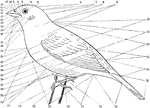
Topography of a Bird
"fig. 25 - Topography of a Bird. 1, forehead (frons). 2, lore. 3, circumocular region. 4, crown (vertex).…
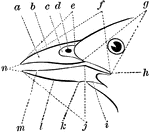
The Parts of a Bird Bill
"Fig. 26 - Parts of a Bill. a, side of upper mandible; b, culmen; c, nasal fossa; d, nostril; e(see…

